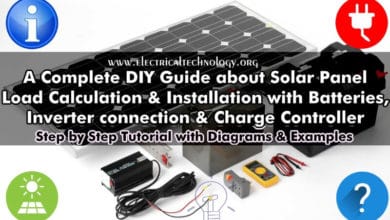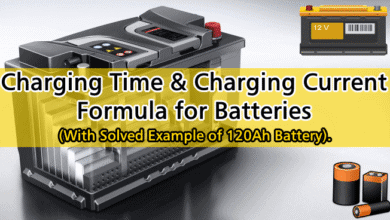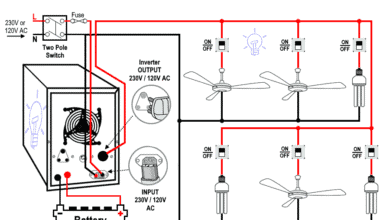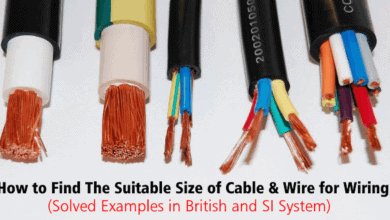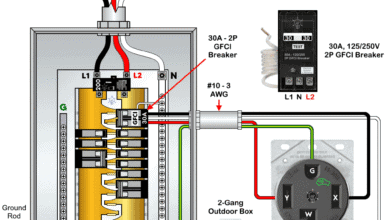Part 5 – Sizing Motor Branch Circuit Conductors and Cables
How to Determine the Correct Wire Size for Motor Branch Circuit?
Sizing Motor Branch Circuit Conductors
Sizing the conductors for motor branch circuit is selected at 125% of the motor FLC [430.22(A)]. The ampacity of branch circuit conductors serving a continuous-duty single motor must not be less than 125% of the motor’s full load current (FLC), as determined by NEC 430.6(A)(1) and 430.22(A) to (G).
The size of conductors for a motor branch circuit is determined using NEC Table 310.16, based on the FLC. The FLC values for different types of motors are listed in NEC Tables 430.147, 430.148, 430.149, and 430.150.
Each table applies to a specific type of motor:
- Table 430.247: DC motors
- Table 430.248: Single-phase AC motors
- Table 430.249: Two-phase AC motors
- Table 430.250: Three-phase AC motors
The ampacity of conductors used for motors must be determined using the values of full load current given in related tables, not the current rating values printed on the motor nameplate.
NEC Article 430, Part II provides guidelines for sizing branch circuit conductors and ampacity without overheating the motors. The following steps shows how to determine the right wire size for motor circuits.
Step 1: Determine the Motor FLC
First, determine the motor’s load type (e.g., continuous, non-continuous, or special-purpose application). Also, choose the conductor material (copper or aluminum) and the type of insulation.
The full load current (FLC) of a motor is found in Table 430.247 (for DC motors), Table 430.248 (for single-phase motors), and Table 430.250 (for three-phase motors).
Step 2: Apply the NEC Sizing Factor (125%)
NEC 430.22(A) states that the branch circuit conductor must be sized at 125% of the motor’s FLC.
The formula to calculate the minimum ampacity of the conductor:
Iconductor = FLC × 1.25
Step 3: Select the Proper Conductor Size
Use NEC Table 310.16 to select the appropriate wire size based on the ampacity calculated in Step 2.
Step 4: Apply Correction Factors (If applicable)
Apply correction factors based on NEC Article 310 if necessary.
For instance:
- Ambient Temperature Correction:
Use Table 310.15(B)(1)(1) and Table 310.15(B)(1)(2) for temperature adjustments at 30°C (86°F) and 40°C (104°F).
- Insulation Type and Rating:
Refer to Table 310.4(1) to ensure compatibility with the selected conductor type (e.g., THHN, THW, XHHW).
- Adjustment Factors for Conductors in Raceway:
Apply Table 310.15(C)(1) when more than three current-carrying conductors are in a single raceway.
- Equipment Terminal Connection Requirements:
Per NEC 110.14(C)(1):
Use the 60°C ampacity rating for equipment circuits rated at ≤ 100A or those marked for 14 AWG through 1 AWG conductors.
Use the 75°C ampacity rating for equipment circuits rated at > 100A or those marked for conductors larger than 1 AWG.
- Voltage Drop Considerations:
Maintain a voltage drop ≤ 3% for single-phase circuits and ≤ 5% for three-phase circuits over long distances.
- Size EGC:
Size the equipment grounding conductor (EGC) based on Article 250.122 and Table 250.122
- Correct Wire Size
Finally, use NEC Table 310.16 to determine the correct conductor size.
Example: 1 – Sizing Conductors for 1-Phase Motor
Determine the appropriate branch circuit conductor size for a 5 HP, 230V, single-phase motor.
Solution:
1. Find the Motor FLC
The full load current for a 5 HP, 230V single-phase motor is determined using Table 430.248
FLC = 28 A
2. Apply 125% Rule for Continuous Load
According to 430.6(A)(1), the ampacity of conductors supplying a continuous-duty motor must not less than 125% of the motor full-load current (FLC) rating:
Iconductor = FLC × 1.25
Iconductor = 28A × 1.25 = 35A
3. Select the Wire Size
Select the wire size for the branch circuit serving a single-phase motor from NEC Table 310.16. According to the table, the correct wire size is #8 AWG (Cu), which has an ampacity of 40A at 60°C. Alternatively, you may use the following conductors at different temperature ratings as a branch circuit for a 5 HP, 230V, single-phase motor:
- #8 AWG Copper (TW/UF) at 60°C (140 °F)
- #10 AWG Copper (THWN) at 75°C (167 °F)
- #10 AWG Copper (THHN) at 90°C (194 °F)
Example: 2 – Sizing Conductors for 3-Phase Motor
Determine the correct size of THWN conductors for a 50 HP, 460V, three-phase motor in a 104°F (40°C) ambient temperature.
Solution:
1: Determine Full-Load Current (FLC)
The full load current of three phase mores are determined by Table 430.250. Based on the table data, for a 25 HP, 460V three-phase motor, the full load current:
FLC = 65 A
2: Apply 125% Rule
Similarly to example 1, the continuous load applications shall be rated at 125%. By apply the NEC 125% rule:
Iconductor = 65A × 1.25 = 81.25 A
3: Apply Correction Factor for Ambient Temp.
From the Table 310.15(B)(1)(1), the ambient temperature correction factor based on 30°C (86°F), the correction factor for THWN at 104°F (40°C) is .88.
81.25A × 0.88
Corrected Ampacity = 71.5A
4: Select Conductor Size
Based on the calculated values, refer to the Table 310.16 to select the wire size for 3-phase motor branch circuit conductors.
- #4 AWG Copper (THWN) at 75°C (167 °F)
- #6 AWG Copper (THWN) at 90°C (194 °F)
Example: 3 – Wire Sizing for DC Motor
What size THHN for branch circuit can be used for a 5 HP DC motor with a 75°C (167°F) conductor temperature rating.
1 – Find the Full Load Current
The FLC for a DC motor is calculated using the power formula or using the Table 230.47:
From the table data, the FLC for 5 HP, 240V:
FLC = 20A
Alternatively, the FLA of a DC motor using power formula
Assuming efficiency (η)= 85% (typical for DC motors):
*We will stick to the NEC Table 230.47 value which is 20A.
2 – Apply 125% Rule for Continuous Load
Iconductor = 20 × 1.25 = 25A
3 – Select the Wire Size
From NEC Table 310.16, #10 AWG (Cu) THHN has an ampacity of 35A, which is sufficient to handle the 25A of current at 75°C (167 °F). Hence, the answer is = #10 AWG Copper (THHN) conductor.
Series Overview: Motor Circuit Calculations
- Part 1 – Motor Load Circuits: NEC Terms and Basic Terminologies
- Part 2 – NEC Requirements for Motor Circuits
- Part 3 – Understanding NEMA Motor Nameplate Data
- Part 4 – Calculating Locked Rotor Current (LRC) for Motors
- Part 5 – Sizing Motor Branch Circuit Conductors … (You are Here)
- Part 6 – Sizing Motor Feeder Conductors
- Part 7 – Sizing Motor Overcurrent Protection and OCPD’s Devices
- Part 8 – Sizing Motor Feeder Protection
- Part 9 – Sizing Motor Overload Protection
- Part 10 – Overcurrent Protection for Motor Control Circuits
- Part 11 – Sizing Disconnecting Means for Motor & Controller
- Part 12 – Sizing Motor Starter & Contactor – NEMA – NEC
- Part 13 – Sizing Direct Online (DOL) Starters/Contactors for Motors (*Bonus)
- Part 14 – Sizing Star-Delta Motor Starters/Contactors for Motors (*Bonus)
Resources & Tutorials:
- Cable Size Calculation for LT & HT Motors
- Three Phase Motor Power & Control Wiring Diagrams
- What is Motor Efficiency & How to improve it?
- Star Delta 3-phase Motor Automatic starter with Timer
- How to Run a Three-Phase Induction Motor on a Single-Phase Power Supply?
- How to Wire ST01 Timer with Relay & Contactor for 120V/240V Motors?
- How to Wire Twin Timer in Repeat Cycle & One-Shot Mode for 120V/240V Motors?
- How to Control a Single-Phase Motor from Multiple Locations?
- Automatic & Manual Control of Motor Using VFD & DOL Starter
- How to Reverse and Forward a Three-Phase Motor Using a VFD?
- How to Wire a VFD with Motor, PLC, Switches & External Devices
- Sequential Motor Control Circuit Using LOGO! V8 PLC
- Automatic Reverse Forward Motor Control Circuit Using Delta – DVP-14SS PLC
- Reverse Forward Motor Control Circuit Using PLC – ZEN Programming Relay
- Motor Protection – Types of Faults and Protection Devices
Wire Sizing Guides
- How to Find the Proper Size of Wire & Cable In Metric & Imperial Systems
- How to Size a Branch Circuit Conductors with Protection?
- How to Size Feeder Conductors with Overcurrent Protection
- How to Size Service-Entrance Conductors and Feeder Cables?
- How to Size Equipment Grounding Conductor (EGC)?
- How to Size Grounding Electrode Conductor (GEC)?
- What is the Right Wire Size for 15A Breaker and Outlet?
- What is the Suitable Wire Size for 20A Breaker and Outlet?
- How Size a Circuit Breaker for Different Load Applications



